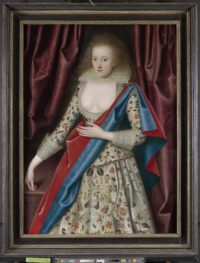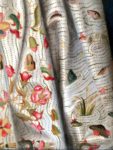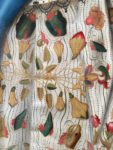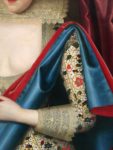 The Yale Center for British Art recently acquired a portrait of a young lady by renowned Jacobean painter William Larkin. The panel painting is believed to be a depiction of Lady Jane Thornhaugh, wife of Sir Francis Thornhaugh, because its ownership history can be traced back through family inheritance to an 18th century Thornhaugh. The inscription provides a date for the portrait — 1617 — and the age of the subject as 17. Assuming on solid grounds that the sitter was a Thornhaugh, only Lady Jane could fit the date and age.
The Yale Center for British Art recently acquired a portrait of a young lady by renowned Jacobean painter William Larkin. The panel painting is believed to be a depiction of Lady Jane Thornhaugh, wife of Sir Francis Thornhaugh, because its ownership history can be traced back through family inheritance to an 18th century Thornhaugh. The inscription provides a date for the portrait — 1617 — and the age of the subject as 17. Assuming on solid grounds that the sitter was a Thornhaugh, only Lady Jane could fit the date and age.
William Larkin’s portraits of early 17th century aristocracy and nobility capture more than just the individuals’ looks. They are invaluable records of the fashions, textiles, accessories, furnishings and styles of the most rarified denizens of James I’s court. Lady Thornhaugh’s gown in this portrait provides a glimpse into the playful motifs popular in Jacobean times, and is even a little scandalous, and I don’t mean the more than generous décolleté.
 She is wearing a masque costume with a pale yellow lace collar and a silk gown embroidered with fantastical flora and fauna, including insects, birds and numerous sea monsters diving in and out of the embroidery. As if that weren’t cool enough (and it is), the yellow color of her lace collar and cuff is a nod to a huge scandal that rocked high society shortly before the portrait was painting.
She is wearing a masque costume with a pale yellow lace collar and a silk gown embroidered with fantastical flora and fauna, including insects, birds and numerous sea monsters diving in and out of the embroidery. As if that weren’t cool enough (and it is), the yellow color of her lace collar and cuff is a nod to a huge scandal that rocked high society shortly before the portrait was painting.
It all started with a poem in praise of the ideal wife. The poet was Sir Thomas Overbury, one of King James I’s favored courtiers. He introduced his bestie Robert Carr to court and Carr quickly rose in the ranks of the king’s retinues, soon becoming his favorite and among the most powerful men in England. Overbury was seen as Carr’s puppetmaster, largely because he was. When Carr began an affair with Frances Howard, Countess of Essex, Overbury protested that it would harm his standing at court as she was notoriously unchaste. Carr ratted him out to Frances Howard, so when Overbury wrote and circulated A Wife, she was sure that was a direct hit on her as the embodiment of none of those wifely virtues.
 The Countess schemed to take Overbury down, spreading malicious gossip about him and then convincing the King to offer him an ambassadorship to Russia which Overbury would turn down, offending James. Overbury got thrown in the Tower of London for that offense, and was dead within months.
The Countess schemed to take Overbury down, spreading malicious gossip about him and then convincing the King to offer him an ambassadorship to Russia which Overbury would turn down, offending James. Overbury got thrown in the Tower of London for that offense, and was dead within months.
Two months after Overbury’s death, Frances Howard had successfully secured an annulment from her husband and remarried to none other than Robert Carr. That’s when the rumors started that there was some kind of shenanigan afoot. Overbury had died too conveniently and too quickly. Could Frances Howard have had a hand in it?
 It took two years for anyone to look into it, but when King James I reluctantly agreed to an investigation, famed jurist Edward Coke and philosopher and statesman Sir Francis Bacon were selected to lead it. The trial in 1616 revealed that Frances Howard had definitely had a hand way up in it. She had replaced the Lord Lieutenant of the Tower with one of her minions and got a new gaoler appointed to tend to Overbury. The gaoler, Richard Weston, poisoned Overbury with sulfuric acid. He was aided in this by Anne Turner, another minion of Frances Howard’s who was well-known for her skills as a yellow starcher who produced the pale yellow collar and cuffs so favored by the fashionable set at court and so sharply detailed in Larkin’s portrait.
It took two years for anyone to look into it, but when King James I reluctantly agreed to an investigation, famed jurist Edward Coke and philosopher and statesman Sir Francis Bacon were selected to lead it. The trial in 1616 revealed that Frances Howard had definitely had a hand way up in it. She had replaced the Lord Lieutenant of the Tower with one of her minions and got a new gaoler appointed to tend to Overbury. The gaoler, Richard Weston, poisoned Overbury with sulfuric acid. He was aided in this by Anne Turner, another minion of Frances Howard’s who was well-known for her skills as a yellow starcher who produced the pale yellow collar and cuffs so favored by the fashionable set at court and so sharply detailed in Larkin’s portrait.
Frances Howard and Robert Carr were convicted of the murder, but quickly pardoned by King James. Anne Turner was hanged from her neck until dead, a neck adorned, as poetic justic would have it, with a yellow starched ruff.
British actress Celia Imrie is the 10X great granddaughter, (I think that was the relation), of Frances Howard, Countess of Essex according to her ep on the show Who Do You Think You Are?.
Wow, great post! The work is so fine that the sea monsters look painted on.
So pale they painted her veins. Another of my pasty pale sisters :love:
Beautiful dress and such interesting details!
There’s a rather good book about the Overbury case, Cast of Ravens: the Strange Case of Sir Thomas Overbury, by Beatrice White. She suggests that his death may not, in fact, have been murder, though leaving not much doubt that Frances was trying.
William Larkin apparently died only two years later in 1619. Unfortunately, I do not know when Isabella Rich was born, but she obviously had to wear the same fancy red and blue sash (and btw a similar décolleté :notworthy: ).
Two years earlier, he had already painted Frances Howard.
———
“Isabel Cope was the daughter of Sir Walter Cope and Dorothy Grenville. She married Henry Rich, 1st Earl of Holland, son of Robert Rich, 1st Earl of Warwick and Lady Penelope Devereux, before 1616. She died circa August 1655. She was buried on 1 September 1655. From before 1616, her married name became Rich.”
Whilst the jacket would be embroidered I suspect the skirt is actually painted silk. The folds are too fluid for the build up of thread that such detailed embroidery would require and painted silks like this were known. Queen Elizabeth had at least one.
Emma, I believe that you are on to something. If you look at the details under the higher magnification it looks more like brush work rather than embroidery stitches. I believe that the little white dots that outline many of the figures may be sewn on seed pearls.
The hair on top of her head seems to be treated strangely. Maybe she originally had a hat? It is fuzzy (sorry for the pun) or out of focus in relationship to the surrounding area and the hair on the sides of her head.
That’s a terrible representation of a 17 year old. She looks in her 40’s.